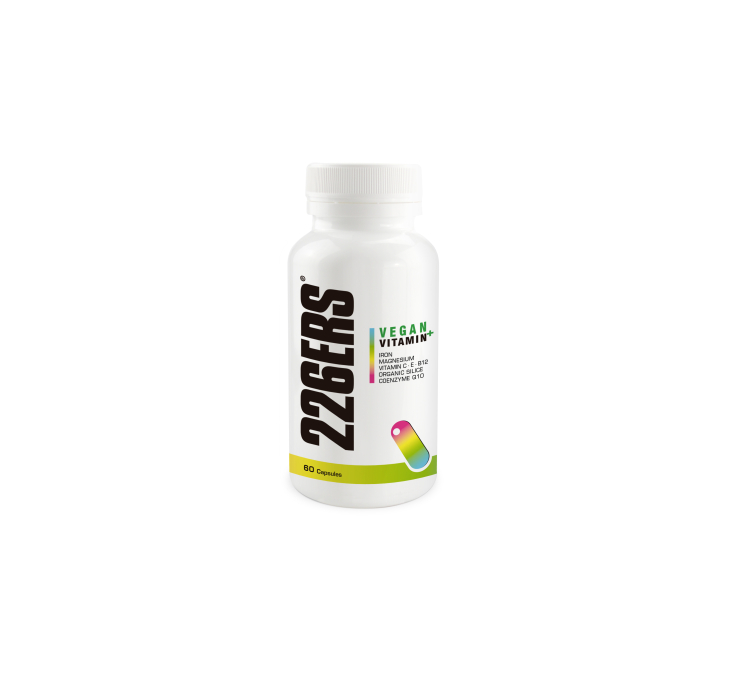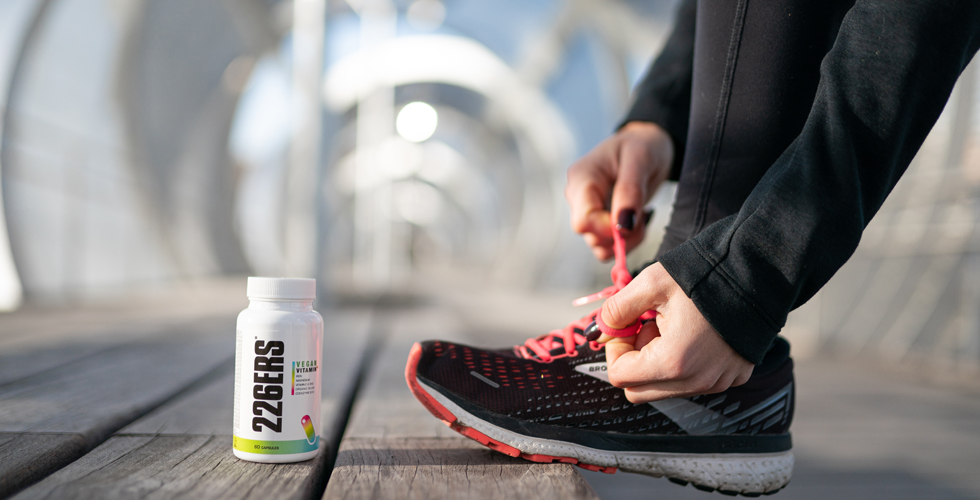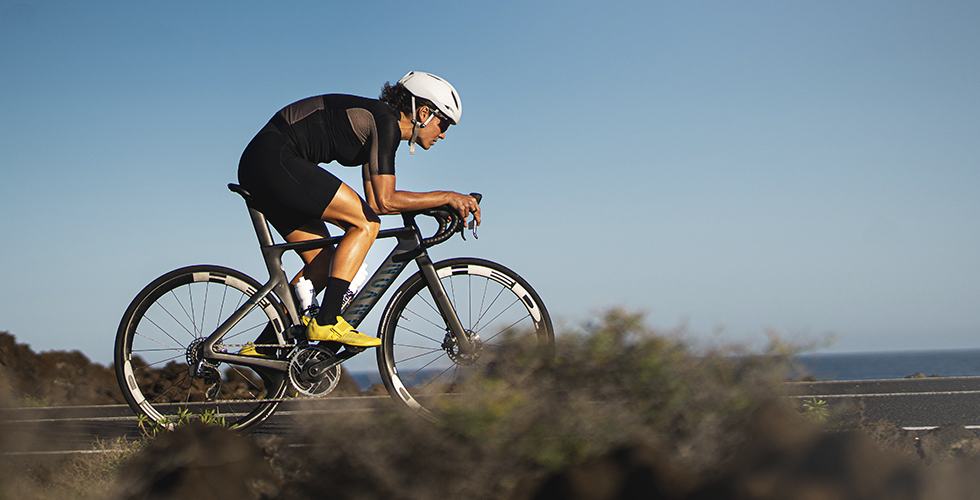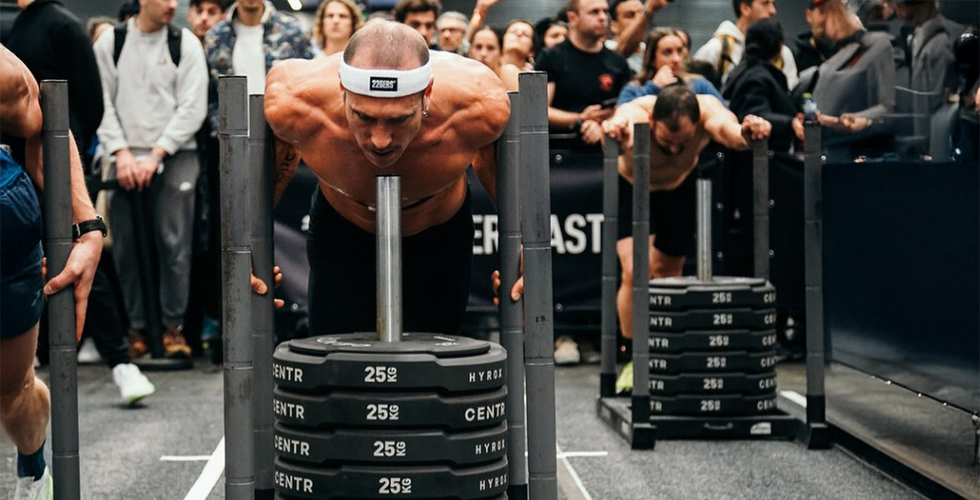Tabla de contenidos
ToggleVitamin C, also known as ascorbic acid, is one of the most well-known nutrients for its role in the immune system. However, its influence goes beyond, especially within sport and exercise. This article explores its role in sports nutrition, its benefits, intake, and scientific research concerning its effect on performance.
c research concerning its effect in performance.
What’s vitamin C?
Vitamin C is a water-soluble vitamin, essential for the human body. It cannot be synthesised by the body, so it must be obtained through diet or supplements. It acts as a powerful antioxidant, taking part in the synthesis of collagen, iron absorption, and the proper functioning of the immune system.
Vitamin C benefits
Amongst its most outstanding benefits:
- Reinforcement of the immune system
- Reduction of the oxidation damage
- Improves tissue healing
- Takes part in the synthesis of neurotransmitters
- Improves iron absorption
Recommended vitamin C intake
The recommended daily intake (RDI) for adult women is 75 mg and 90 mg for men, although the requirements can increase in athletes or oxidative stress situations. Daily additional amounts vary between 200 and 1,000 mg, although more isn’t always better.
Recommended intake depends on the goal and type of workout performed:
| Workout type | Goal | Suitable amount | Ideal intake | Timing |
| Endurance workout (running, cycling, triathlon) | Reduction of oxidative damage and immune support | 200–500 mg/day | Preferably after exercise | During high impact or peaking for a race |
| Strength workout (weight lifting, crossfit, HIIT) | Muscular protection, collagen synthesis | 500–1.000 mg/day | Post workout or with meals | High intensity or recovery periods |
| Post injury recovery | Tissue repair, structural support | 500–1.000 mg/day + protein | Main meals | Rehab phase |
| Extreme condition workouts (altitude, heat, cold) | Protection against environmental stress | 500 mg before + 500 mg after | Before and after workout | While being under stress |
| Infection prevention (after trips, back to back races) | Immune reinforcement | 500–1.000 mg/day | Morning or breakfast | 7–14 days in short terms |
Natural sources of vitamin C
The richest foods in vitamin C and most suitable for an appropriate source are:
- Red pepper
- Broccoli
- Papaya
- Guava
- Citric fruits (orange, lemon, grapefruit)
- Kiwi
- Strawberries
Following a diet rich in fruits and vegetables ensures a good source of this vitamin, as its bioavailability in fresh foods is optimal.
Vitamin C for athletes
Free radicals, which can harm muscle tissue and affect performance, are produced during intense exercise. Vitamin C can help counteract these effects thanks to its antioxidising capacity. It can also favour a faster recovery and the prevention of post workout infections.
While exercising, especially during intense or long sessions, more reactive oxygen species (ROS) are released, commonly known as free radicals. These unstable molecules can harm cellular structures such as membranes, proteins, and DNA. This process is known as oxidative stress and has been linked to muscle fatigue, performance worsening, and a greater recovery time.
Here’s where vitamin C comes into play, one of the most powerful antioxidants available in the diet. Its capacity to donate electrons allows it to neutralise free radicals and limit tissue oxidative damage. This action can mean several benefits to athletes:
Protection against muscle damage
Studies have shown that vitamin C supplementation can reduce muscle damage biomarkers such as creatine kinase (CK) and lactate dehydrogenase (LDH), especially after eccentric or high-intensity training. This suggests that it helps preserve muscle tissue integrity against exercise-induced wear and tear.
2. Enhances post exercise recovery
By minimising inflammation and oxidative damage, vitamin C can accelerate cellular repair after training. Its role in the collagen synthesis also favours tendon, ligament and muscle regeneration. Some studies report a lower perception of delayed onset muscle soreness (DOMS), when taking vitamin C, although results are variable.
3. Supporting the immune system during intense training phases
High-load periods such as specific overload blocks or racing weeks can temporarily depress the immune system, which increases the risk of respiratory infections. Vitamin C fortifies the functions of immune cells such as neutrophils and lymphocytes, helping to prevent infections that could interfere with the training or competition program.
4. Performance modulation under stress
Although it doesn’t act directly as a performance enhancer, under high environmental or metabolic stress (altitude, heat, fatigue), vitamin C can improve the body’s redox state and promote the physiological adaptation.
Vitamin C, muscle recovery and fatigue: a key workout synergy
Exercise, especially when it’s intense or long, entails a number of complex physiological processes which challenge the body’s internal balance. Amongst them, the most outstanding one, the increase in oxidative stress caused by the high production of free radicals. Here, vitamin C plays a strategic role due to its antioxidant properties, its influence in muscle recovery, and indirect impact in fatigue.
Anti-oxidising properties and cellular defence
During intense muscle contraction, the increase in mitochondrial oxygen consumption creates free radicals. Although these accomplish adaptive signalling functions, an excess can damage lipids, proteins, and cellular structures, including muscle fibers. Vitamin C, as a water-soluble antioxidant, neutralises these unstable molecules, helping to protect muscle cell membranes from lipid peroxidation, reducing acute inflammation induced by exercise, and decreasing post-exercise muscle soreness, such as delayed onset muscle soreness (DOMS).
Besides preserving cellular integrity, vitamin C can shorten recovery times and improve tolerance to intense training.
Muscle recovery: beyond what’s structural
Vitamin C also takes part in repair processes. It’s essential for collagen synthesis, a key protein in the structure of muscle, tendon, and ligament tissue. This structural function is especially relevant during certain phases:
- Muscle micro injuries that occur after endurance or strength workouts.
- Periods of progressive adaptation, where tissue regeneration must accompany training overload.
Several studies have shown that an adequate intake of vitamin C (especially combined with vitamin E or polyphenols) can reduce muscle damage markers (such as creatine kinase), and speed functional recovery.
However, it must be underlined that an excess of antioxidants could interfere with signs of mitochondrial adaptation to exercise, especially in endurance disciplines, where a certain amount of oxidative stress is necessary to stimulate physiological improvements.
Vitamin C and fatigue: prevention, not stimulation
Although vitamin C doesn’t act as a direct stimulant of the nervous system, its influence on fatigue perception is tied to:
- Oxidative stress reduction, which at high levels, compromises cell energy efficiency.
- Correcting slight nutritional deficiencies that can cause chronic fatigue in badly fed athletes.
- Cortisol modulation, stress hormone that rises with excessive training and can cause the feel of exhaustion.
Hence, the role of vitamin C towards fatigue is mainly preventive and as a metabolic support, helping to keep an overall feeling of energy and wellness during demanding training blocks.
Properly integrating vitamin C into the diet or supplementation of an athlete can be a valuable ally to protect muscle, favour post-workout recovery, and prevent excessive physical attrition. However, as a potential ergonutrient, its intake must be strategic and moderate; too much can be as harmful as too little.
Vitamin C supplementation and its relationship with training
Vitamin C supplementation is a frequent nutritional tool among athletes, especially those subjected to intense or long workouts. It’s available in different forms: tablets, capsules, powder, or effervescent formulas. Its main goal is to complement the diet when requirements increase, either due to high oxidative stress, intense physical demands, or dietary limitations.
While a balanced diet rich in fruit and vegetables is usually sufficient to cover basic needs, in sporting contexts, it may be useful to use supplements. However, it’s important to choose products certified for their quality and to avoid megadoses of more than 2,000 mg per day, as these can cause adverse effects such as gastrointestinal discomfort, and in the long term may even interfere with training-induced physiological adaptations.
The best time to obtain the benefits of vitamin C supplementation would be:
- Together with iron, fasted or before breakfast.
- With a meal rich in flavonoids (to empower its anti-oxidising effect).
- Avoid its intake with calcium, that can interfere the absorption of both.
When to take vitamin C; before or after exercising?
Intake timing can make a difference. Taking vitamin C after exercise appears to be more beneficial, as it helps counteract the increase in free radicals generated during physical activity, reducing cellular damage and facilitating recovery.
However, in certain situations, such as high-altitude training, extreme environmental conditions or particularly demanding sessions, a pre-exercise intake may offer preventive protection against oxidative fatigue and early muscle deterioration.
To favour absorption, it’s suitable to avoid unnecessary megadoses, as taking 1.000 mg or more in a single dose doesn’t significantly improve antioxidant or immunological efficacy. In athletes, it may lead to renal overload without additional benefit, and may even interfere with training adaptations.
Fractionating the dose by dividing the total intake into two or three daily intakes of 100-200 mg may promote or increase total net absorption and maintain more constant plasma levels. It can also optimise its role in iron absorption, immune protection and antioxidant protection.

VEGAN VITAMIN + - Vitaminas Veganas - 60 Cápsulas
Cápsulas veganas formuladas específicamente para cubrir las necesidades del deportista sea cual sea su nivel.
Con 24 vitaminas y minerales, un extra de Silicio Orgánico del Bambú y Coenzima Q10.
Vitamin C absorption
Vitamin C is effectively absorbed by the body up to a certain threshold. Amounts above 200 mg are usually absorbed poorly, and the excess is excreted in urine. It’s therefore preferable to divide the dose into smaller doses.
Intestinal absorption is very efficient at low amounts: ~70-90% absorption at doses of 30-180 mg. As the amount increases, efficiency decreases, becoming less than 50% for doses >1.000 mg. At amounts >2.000 mg, absorption may drop to <30%.
Above 200 mg, the intestine begins to saturate, and the excess is excreted in urine thanks to the aqueous solubility of vitamin C and its rapid renal elimination (glomerular filtration and active tubular secretion). As a water-soluble vitamin, it’s not stored in large quantities and the body regulates its levels through renal reabsorption, but when the plasma becomes saturated, it’s eliminated with some ease. Stable serum levels require frequent and moderate intakes, rather than occasional acute mega-doses (to compensate for deficiencies).
Taking it fasted or with food?
Although vitamin C is water-soluble and is effectively absorbed even when fasting, there is no strong evidence to suggest that taking it while fasting increases its efficacy. As a precaution and to avoid possible gastric discomfort, especially in sensitive people, it may be more suitable to take it with meals, which doesn’t significantly affect its bioavailability.
However, vitamin C plays a key role in the absorption of iron, which is susceptible to absorption inhibitors (such as phytates, calcium or tea/coffee tannins). Vitamin C reduces ferric iron (Fe³⁺) to ferrous iron (Fe²⁺), which is the absorbable form in the small intestine. It also forms a soluble complex with iron, which facilitates its absorption. Athletes, especially endurance ones (runners, cyclists, swimmers), may be at risk of iron deficiency for several reasons:
- Intravascular haemolysis (destruction of red blood cells by impact, e.g. in runners).
- Sweat loss or gastrointestinal bleeding.
- Insufficient intake in restrictive or vegetarian diets.
- Increased demand from intense training.
In these cases, iron is essential to maintain haemoglobin production, optimise oxygen transport and maintain aerobic performance. Combined supplementation (iron + vitamin C), may be necessary when there’s evidence of:
- Ferritin <30 ng/mL (indicative of low stores).
- Low iron serum or decreased transferrin saturation.
- Confirmed iron deficiency anaemia (low Hb with low iron).
- Symptoms such as persistent fatigue, decreased performance.
Strategic use within training context
The use of vitamin C in sport must be intelligent and adjusted to the athlete’s real needs. During high training load, competition or recovery phases, its intake can be key to protect muscle tissue, strengthen the immune system and reduce recovery time. However, prolonged use in high doses has been linked to a possible inhibition of mitochondrial adaptations and certain stress signals necessary to improve endurance and strength. Therefore, occasional, cyclical and supervised use is suitable, avoiding routine and excessive use in well-nourished athletes.
Best time to have vitamin C
The best time can vary according to the goal:
- Overall immunity: in the mornings with breakfast.
- For recovery: after training.
- To prevent infections: before or after trips, races or intense workouts or during winter, when training load is combined with the weather, which is prone to virus infections.
High amounts of vitamin C: when does it become a problem?
Although scientific evidence shows that vitamin C is essential, its supplementation in high amounts (>1.000 mg/day), can have counterproductive effects in athletes, especially in endurance sports. This may be due to interference with training adaptations:
- Exercise stimulates a physiological oxidative response (ROS increase), that activates beneficial cellular pathways (mitochondrial biogenesis, angiogenesis, insulin sensitivity).
- High amounts of antioxidants such as vitamin C (and E), can diminish these signals and reduce the improvements in aerobic capacity, VO₂max, mitochondrial efficiency and insulin sensitivity.
Prolonged and continued exposure to amounts over 1.000 mg/day without periodising nutritional requirements associated both with habits and training plan, trips or competitions, can also produce gastrointestinal discomfort (nausea, diarrhoea, cramps), oxaluria and risk of kidney stones (vitamin C is converted to oxalate), possible interference with training adaptations, blocking beneficial oxidative signals, unbalancing iron metabolism.
Vitamin C to improve sports performance
Although not a direct ergogenic, vitamin C can contribute to indirectly enhance performance by improving recovery, reducing muscle damage and keeping the immune system strong. Its effect is most noticeable under high physical stress or nutritional deficiencies.
Vitamin C can be a strategic support for athletes, especially in phases of high load, recovery or when there’s a risk of nutritional deficit. Its use should be individualised, cyclical and well dosed to avoid adverse effects and optimise its benefits.





